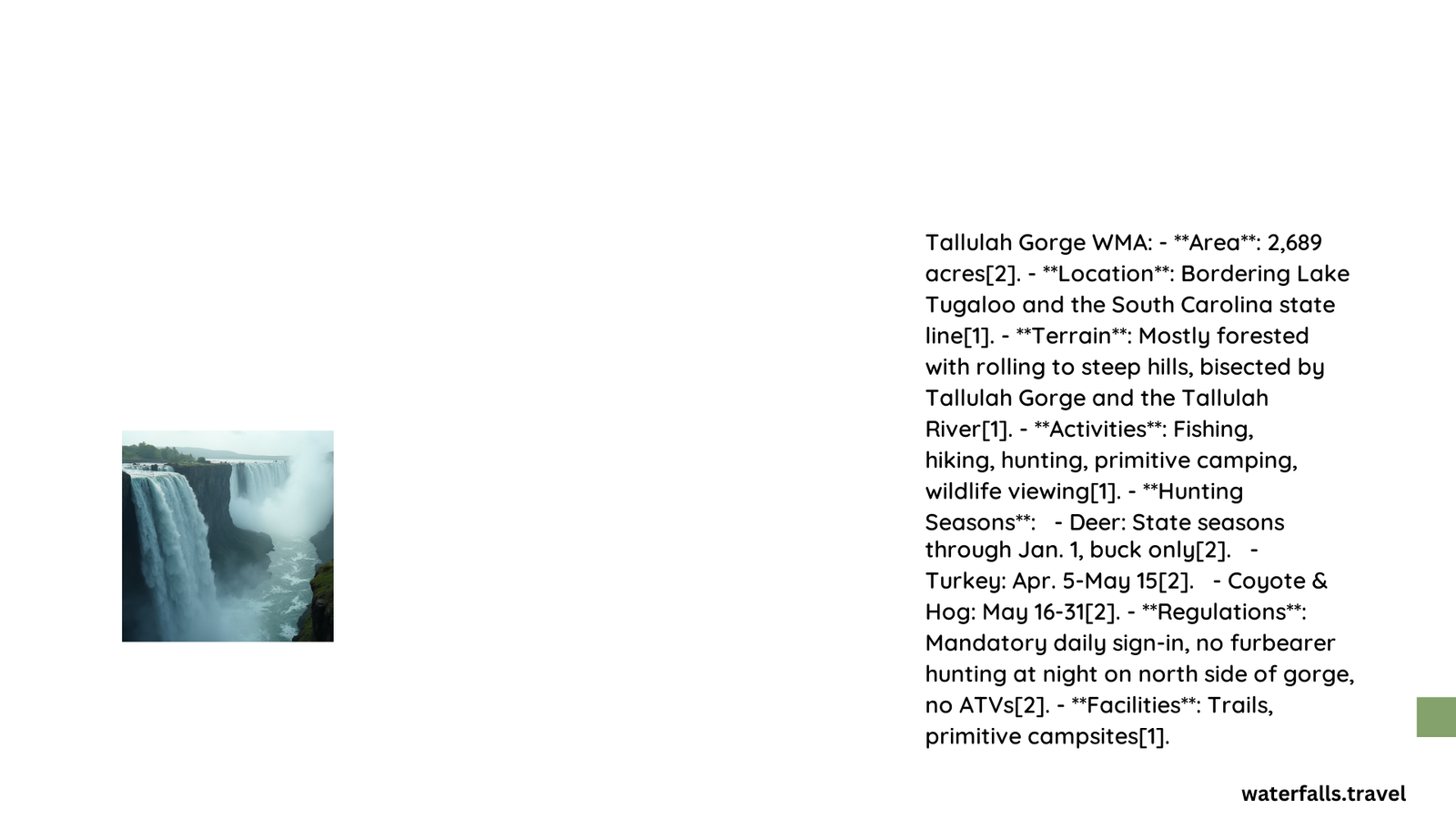Tallulah Falls WMA, located in northeast Georgia, is a stunning natural area encompassing the dramatic Tallulah Gorge. This Wildlife Management Area offers diverse recreational opportunities, including hiking, camping, fishing, and wildlife viewing. The WMA is adjacent to Tallulah Gorge State Park, providing visitors with access to both protected areas. With its unique geological features and rich biodiversity, Tallulah Falls WMA attracts nature enthusiasts, hikers, and outdoor adventurers year-round.
What Are the Main Attractions of Tallulah Falls WMA?
Tallulah Falls WMA boasts several key attractions that make it a must-visit destination:
- Tallulah Gorge: A 1,000-foot deep canyon carved by the Tallulah River
- Scenic hiking trails with breathtaking views
- Diverse wildlife and plant species
- Fishing opportunities in the Tallulah River and nearby lakes
- Hunting seasons for various game species
How Can Visitors Access the Hiking Trails in Tallulah Falls WMA?

Tallulah Falls WMA offers a variety of hiking trails catering to different skill levels:
North and South Rim Trails
- Length: Approximately 3 miles round-trip
- Difficulty: Moderate
- Features: Mulched path, some inclines and stairs, scenic overlooks
Sliding Rock Trail and Gorge Floor Trail
- Difficulty: Strenuous
- Requirements: Free permit required, proper footwear mandatory
- Restrictions: No pets allowed
- Features: Over 1,000 stairs, access to gorge floor
Stoneplace Trail
- Location: Extends from the park into the WMA
- Requirements: Free permit required
- Note: During hunting season, permits are not issued until after 10 AM
What Camping Options Are Available in the Area?
Visitors to Tallulah Falls WMA have several camping options:
- Terrora Campground:
- Location: Within Tallulah Gorge State Park
- Capacity: 50 RV/tent sites
-
Reservation: Available or first-come, first-served basis
-
Pioneer Campground:
- Type: Primitive camping experience
-
Reservation: Recommended due to capacity limits
-
Backcountry Adirondack Shelters:
- Type: Rustic, secluded camping option
- Reservation: Recommended due to limited availability
What Are the Fishing Regulations in Tallulah Falls WMA?
While fishing is not the primary focus of Tallulah Falls WMA, there are opportunities for anglers:
- Location: 63-acre lake within the state park
- License: Valid Georgia fishing license required
- Regulations: Specific rules for species and limits apply
- Best Practice: Check with Georgia Department of Natural Resources for current regulations
What Wildlife Viewing Opportunities Exist in Tallulah Falls WMA?
Tallulah Falls WMA offers excellent wildlife viewing opportunities:
Protected Species
- Persistent trillium
- Monkey-face orchid
- Green salamander
Common Wildlife
- Deer
- Bear
- Turkey
- Coyotes
Best Viewing Locations
- Scenic Overlooks:
- Inspiration Point
-
North and South Rim Trails
-
Gorge Floor:
- Requires strenuous hike
- Offers close-up views of unique flora and fauna
Viewing Tips
- Best times: Early morning and late afternoon
- Follow park rules and stay on designated trails
- Avoid disturbing wildlife
- No pets allowed on certain trails and gorge floor
What Are the Logistical Aspects of Visiting Tallulah Falls WMA?
Parking
- Available within the state park
- Specific capacity and fees not detailed (check with park directly)
Accessibility
- Varied trail difficulty levels
- Interpretive center designed for accessibility
- Some trails may be more accessible than others
Transportation
- No public transit or shuttle services mentioned
- Personal vehicle recommended
What Events and Seasonal Activities Are Available at Tallulah Falls WMA?
Tallulah Falls WMA offers a range of seasonal activities and events:
Scheduled Water Releases
- Timing: First two weekends in April and first three weekends in November
- Purpose: Whitewater boating and increased water flow viewing
Hunting Seasons
- Species: Deer, bear, turkey, and coyote
- Regulations: Specific rules and sign-in requirements apply
- Location: Within the WMA boundaries
Year-round Activities
- Hiking
- Biking
- Picnicking
- Swimming (seasonal)
- Educational programs at Jane Hurt Yarn Interpretive Center
Climbing
- Permits available
- Seasonal restrictions due to peregrine falcon nesting
How Does Tallulah Falls WMA Contribute to Conservation Efforts?
Tallulah Falls WMA plays a crucial role in conservation:
- Habitat Protection:
- Preserves unique ecosystems within the gorge
-
Maintains biodiversity of flora and fauna
-
Species Conservation:
- Protects endangered and threatened species
-
Monitors wildlife populations
-
Environmental Education:
- Offers programs to raise awareness about local ecology
-
Promotes responsible outdoor recreation
-
Resource Management:
- Implements controlled hunting to manage wildlife populations
- Conducts regular environmental assessments
What Safety Precautions Should Visitors Take at Tallulah Falls WMA?
When visiting Tallulah Falls WMA, consider these safety measures:
- Trail Safety:
- Wear appropriate footwear for hiking
- Stay on designated trails
-
Carry water and snacks
-
Wildlife Encounters:
- Keep a safe distance from animals
- Store food properly to avoid attracting wildlife
-
Know how to respond to bear encounters
-
Weather Preparedness:
- Check weather forecasts before visiting
- Bring appropriate clothing for changing conditions
-
Be aware of potential hazards during storms
-
Emergency Preparedness:
- Carry a first aid kit
- Have a communication device (note that cell service may be limited)
-
Inform someone of your hiking plans
-
Hunting Season Awareness:
- Wear bright colors during hunting seasons
- Be aware of hunting zones and schedules
By following these guidelines, visitors can safely enjoy the natural beauty and recreational opportunities of Tallulah Falls WMA while contributing to its conservation efforts.
